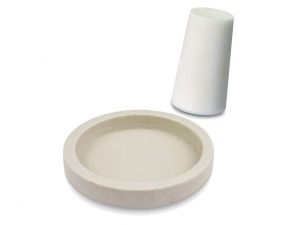Both Borax cones, or Borax bars, and dishes are brilliant soldering tools for building up your workshop, but what’s the best way to use them and how do you keep them clean? Discover our top tips on how to use a borax cone and dish to get started with the soldering process.

What is Borax used for?
Borax, also known as sodium tetraborate, is a powdery white mineral that is often used as a cleaning product. There are several uses for Borax around the house, including getting rid of stains, mould and mildew. But in jewellery making, it is used in the process of soldering metal. It helps the solder to flow while preventing the metal from oxidising and the risk of fire stains.
[iframe width=”560″ height=”315″ src=”https://www.youtube.com/embed/lNQ893OyP20″ ]
Borax bars are made from compact, dried flux and are used with water to create a paste that is suitable for soldering precious and non-precious metals. While a Borax dish is made of unglazed ceramic to create a rough surface to grind the Borax on.
How do you use a Borax cone and dish?
Start by pouring a small amount of water into your dish and grind the Borax cone with a small amount of pressure in a circular motion around the dish – forming a dense paste. Then take a flux brush to apply to your metal join with the solder and you’re ready to go!
Some liquids frequently used with Borax to create flux include:
- Distilled water
- Regular water
- Methylated spirits
- Denatured alcohol
Although the last two can evaporate quite quickly so you may find it easier, and cheaper, to use water.
How much water do you add to a Borax dish?
When creating your flux using a Borax bar and dish, it’s important to not use too much water. Too much water stops the flux slurry from being able to form into a thicker paste – which is needed to be able to solder effectively. So just a few drops of water in the centre of the dish is a great place to start, and then the more flux you need the more water you may need to add. If you’re unsure, you can start with coating the surface of the dish in water and then pouring away the excess – what’s left will be enough for you to work with.
But when you’re returning to the workshop on a Monday morning after a weekend off, you may find that your Borax dish soaks up more of the liquid that you’re adding in, so you’ll need a little more than usual to get your flux started. Start off with a smaller amount and add more as you go to get the right consistency and the correct amount of flux that you need. Throughout the day, you’ll probably find that you won’t need to be adding as much water because the dish becomes denser and won’t take in as much of the liquid.
Top tip: Keep your water in a squeezy bottle or another liquid container with a small tip to make it easier to dispense onto the dish in small doses.
How do you clean a Borax cone and dish?
Before you start, you need to make sure that your Borax dish is clean, as any foreign substances that can get mixed in with the flux will affect the soldering process. Though if you’ve come back to an old Borax dish coated in hardened slurry/flux, you can “recharge” it with a little more water and re-grind your cone to reform the slurry. But over time, you may find that an excess of hardened Borax starts to build up the sides of the dish. In this case, all you need to do is soak the dish in water and chip the excess off. These chippings of Borax can then be used when you come to melt down your metal, instead of using powdered flux.
There’s no real issue with your cone being dirty, but while you’re working with polishing tools and other jewellery techniques, the dirt on your fingers can transfer onto your cone. So if you feel that it’s building up, then all you need to do is run the cone under the tap to give it a wash and a scrub to clean up the outside. If the slurry you are creating no longer looks white, then you can wash off the excess Borax to create a clean slate. Your cone may also get stuck to the bottom of the dish, but you should be able to easily break it off and start again.
Top tip: If you’re keeping your Borax cone and dish to hand on your workbench, make sure to clean your bench regularly to avoid any dust or dirt from contaminating your Borax and solder. You can also lightly sand down and clean the surface of the metal before you start soldering to make sure that you’re working with dust and dirt-free materials.
Looking to solder? Browse our complete range of jewellery soldering tools and equipment to find everything you need. From soldering blocks and sheets to butane torches and brushes.

Cooksongold
